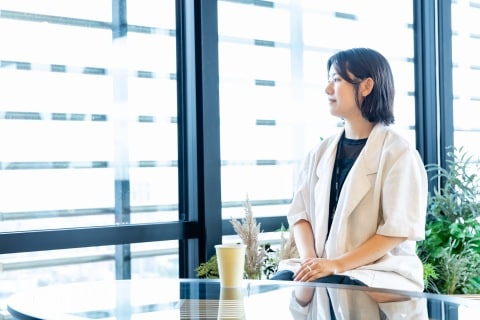PEOPLE
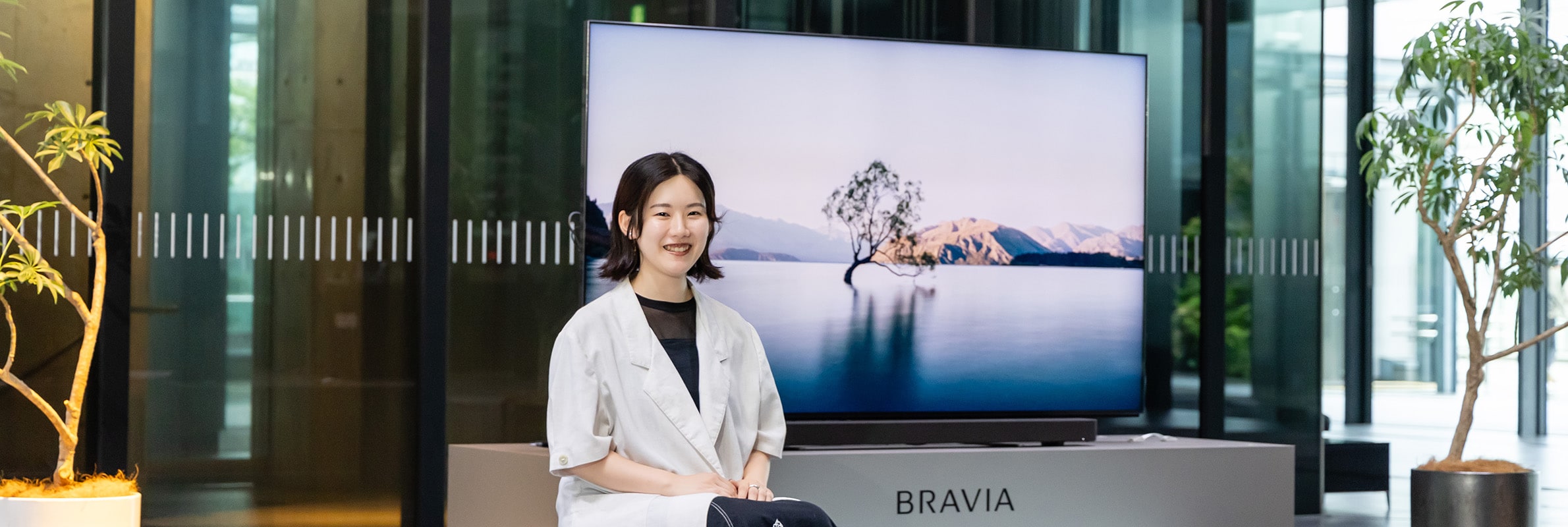

Listening to customer feedback to create products and services that are even more comfortable to use. I am for an easy-to-use experience for every customer, regardless of age or culture.
Rin Ito
Sony Corporation
Manufacturing from a customer perspective is a mindset shared throughout Sony
Since joining Sony Corporation in 2022, I have been involved in the design of user interface (UI) and user experience (UX) for televisions. I am also a member of the Human-Centered Design (HCD) Section, which promotes HCD, and I support product development that considers accessibility. The Screen Reader function installed in TVs does more than just read out the words displayed on the screen—it must also communicate the current status and screen configuration so that users can operate the TV without relying on visual information. My work consists of informing developers of these needs, unifying the expressions used when reading words on the screen aloud, and checking the ease of use on the actual screen.
Although it's only my third year at Sony, I feel that HCD is becoming more widespread within our company every year. New employees receive training on HCD regardless of department, and some employees voluntarily participate in training to update their skills. In this way, HCD is becoming a shared mindset throughout Sony. Therefore, as a member of the HCD Section, I am motivated to work even harder to lead product development based on HCD.
- *Accessibility:The ability to use products, services, and entertainment regardless of personal characteristics (age, disabilities, etc.), competencies, or environment.
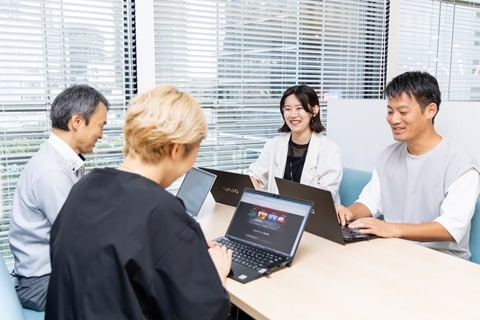
Pursuing UI/UX design that is easy to use for everyone, regardless of age or culture
I became interested in HCD because of my grandparents. I remember one time when my grandparents wanted to enlarge the display size for text on their mobile phones, but didn't know how to configure the settings. They accidentally deleted their data and were unable to recover it. Whenever my grandparents had a problem like this, they would contact my mother or myself for help. Eventually, my grandfather lost full use of one of his hands due to illness. He was no longer able to use chopsticks as he had before, so he started using forks and chopsticks with assistive functions. Even since I was a child, I had loved creating new things. Seeing my grandparents' experiences with technology made me to wonder how to design things that many people could use with greater ease and comfort. Acting upon this interest, I decided to study kansei engineering (affective engineering) at university. Kansei engineering involves analyzing human sensibilities and sensations, and then using analysis results to create products and services that are easy to use and comfortable for users.
The formative experiences which I had studying abroad and traveling abroad during my time at university also deepened my interest in HCD. When staying at a private lodging in France, I tried to use the washing machine and suddenly the floor around the washing machine was covered in soap suds—I couldn't help but panic! Although I hadn't expected any significant differences in functions, the button signs that are commonplace for people in France were unfamiliar to me as a Japanese person. Even though I understood the words, I failed to comprehend their meaning. I realized that even in an age when anything can be look up on a smartphone, there are still many things that can't be understood or that are inconvenient. This experience inspired me to create things that are easy to use for a variety of users, regardless of age or culture.
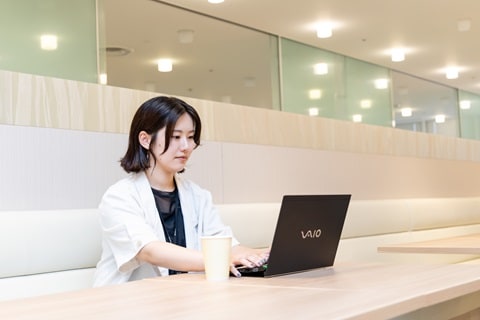
Developing BRAVIA apps to transform living rooms into even more comfortable spaces
In graduate school, I studied manufacturing processes and UX design. When looking for a place to work, I placed importance on the company's attitude toward HCD. Sony has more than 100 courses for new graduates and allows employees to select work which they find appealing. Some of these courses look for people capable of working on HCD, which is rare at other companies. I was impressed by how serious Sony is about HCD, so I submitted my job application.
I am currently involved in UI/UX design for the BRAVIA app “Living Decor.” A large-screen TV is one of the focal points of a living room. However, when a TV is turned off, it appears as nothing more than a large black board. Such TVs may clash with the living space, and may even feel oppressive at times. In response to this issue, Living Decor creates a more comfortable space by using the TV as a photo frame that shows images, plays music, or functions as a clock.
The Living Decor app allows users to play a variety of videos and music, as well as display content created in collaboration with Sony Group companies on their TV screen. I am also working on other such new ideas. However, I make sure not to get caught up in my own viewpoint; rather, I focus on using an HCD perspective. Specifically, I focus on HCD when considering what kind of images or music would please users, what kind of title or description would be appealing, and what would be the best plans to entertain users.

Visiting the homes of customers to investigate ease of use
HCD is concept in which products are created based on user feedback. In addition to conducting surveys and interviews, I also visit customers' homes to see how they actually use our products. In my second year at Sony, I had the opportunity to spend two months in California (USA) and participate in home visit surveys with the local research team.
I had previously observed home visit surveys remotely from Japan and asked questions via chat, but actually visiting homes gave me a different sense of realism. I was able to clearly observe users' facial expressions, small hand movements, and momentary hesitations before the next operation. These subtle aspects are difficult to notice remotely through a screen. It was also a valuable experience to see firsthand how Sony products are used in living environments which differ from Japan. I learned a great deal from the techniques used by the research team to create a relaxed atmosphere and elicit honest feedback from users who they were meeting for the first time. In the year I joined Sony, I participated in an inclusive design workshop which involved walking around the city together with people with disabilities. In this way, Sony is unique in how it offers many on-site learning opportunities for young people.
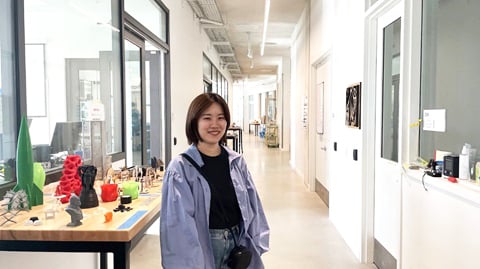 Touring a university in America
Touring a university in America(Design Lab, University of California San Diego)
The joy of customers brings me fulfillment
I feel very rewarded by my work when the UI/UX design I was involved in is well-received and I witness the happiness of customers. My most memorable experience during the home visit survey in the United States was visiting the home of a man with visual impairments. We asked him to try setting up a TV to see if the process went smoothly. Previously, he had wanted to set up a TV by himself, but ultimately had to ask a friend for help. However, during our visit, he was overjoyed at being able to successfully complete the setup by himself. Seeing his happiness made me realize the great significance of creating products that consider accessibility. I was touched by seeing the joy on his face.
Of course, I am unable to create UI/UX design by myself. Instead, I propose specifications and then work together with designers to realize those specifications. All members of our team work hard together. When our designs actually work on a TV screen, I feel a great sense of accomplishment. Receiving positive feedback from users makes me even happier.
Although I had participated in manufacturing projects in graduate school, a much greater number of people are involved in projects implemented at corporations. This work comes with responsibility. Therefore, when proposing a new function, I must be able to logically explain the basis for the function before asking for cooperation. I feel that my attitude toward manufacturing has changed significantly since I joined Sony.
 With BRAVIA development team members
With BRAVIA development team membersHuman-Centered Design can be applied to the development of any product or service
Looking back on my life so far, I have long thought about manufacturing from the user's perspective—ever since I first began helping my grandparents with their problems. This theme is at the core of my interests, and I believe it is a theme worthy of devoting my life to exploring.
Currently, I'm facing a challenge in the process leading up to the selection of BRAVIA by customers. For example, how can I help customers recognize the value of BRAVIA when there are so many different TVs on display in a consumer electronics store? I believe there is still room to incorporate an HCD perspective into the process leading up to product purchase.
UI/UX design for televisions is complex, and I understand that I need to refine my skills. Although the proliferation of smartphones has made touch panel operation widespread, TVs are still operated by remote control. The approach to creating a screen differs completely for touch panels and remote controls. With this in mind, I would like to pursue UI/UX design that is unique to remote control operation.
Eventually, I would like to work on products and services other than televisions. The concept of HCD can be applied to a variety of fields. The development process is the same regardless of the product or service—start by listening to customer feedback, then engage in research and analysis to create something that is easy to use and desired by customers. Due to these shared aspects of development, I am certain that my past experience will be useful in my future work. Going forward, I would be happiest if I could refine my skills and work with various people to create unprecedented new experiences.
